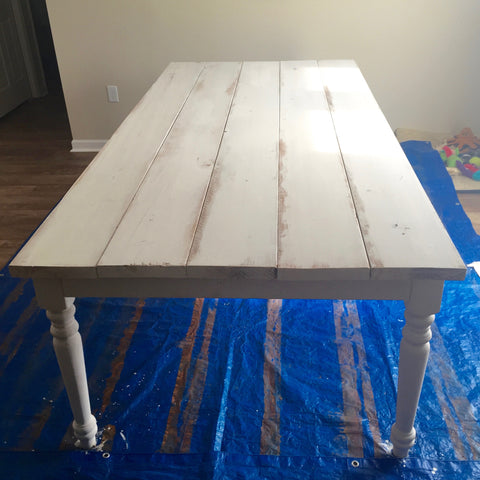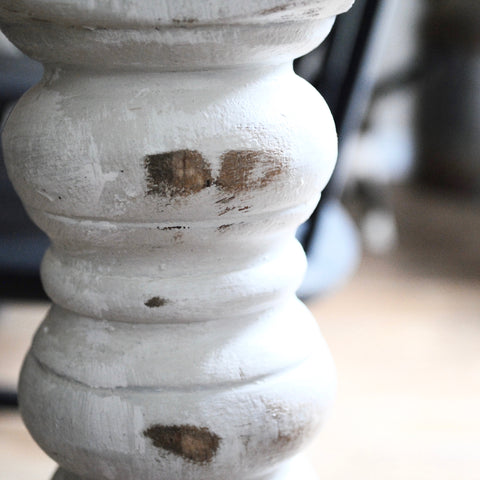I absolutely love the modern-farmhouse/cottage style. I've been acquiring pieces and staging my decor to add that delightful southern charm to my home. We recently moved into a new place and I've been quickly filling it up with decor pieces that I love. Some items came with us, others were found and foraged from my hours spent at antique stores and flea markets, but this mirror found me in a really cool salvage/thrift shop called Construction Junction in Pittsburgh, PA.
I say "it found me" because I had no intention of purchasing a mirror that day. I went shopping the first week of March, right before we were moving out of the area. I was walking around looking for structural pieces and large furniture to take with us, when it jumped out and said "Taylor take me home!!" (okay, not literally, I know mirrors don't talk, but it did speak to my soul, if you know what I mean). How could I say no? It was real wood, heavy, and oh my goodness those curves!
...$20 later and it was coming home with me for a makeover.
The mirror got packed up and unpacked into our new bedroom, where it found a home on the floor in the corner. I left it there while I worked on some other projects, including this simple ottoman I made and these dining chairs I refinished. Fast forward to this Friday, when I decided it was finally time for the makeover party:
I gathered my materials:
- The gorgeous mirror
- Rags
- Newspaper
- Miss Mustard Seed’s Milk paint in Farmhouse White
- Miss Mustard Seed’s Bonding Agent
- Paint brush
- Small cup for mixing lender, water
- Blender
- Water
- Painter’s tape
- Hair dryer
- Extension cord
- Sander and medium grit sand paper
I took my mirror to the kitchen where I used a rag to wipe down the wood frame. This helped get the dust off and made sure the paint had a clean surface to adhere to. Then I moved the mirror outside and laid it down on top of some newspaper.
While the frame was drying, I mixed up some milk paint. If you’ve never worked with milk paint before, it is amazing- you’ll love it! Not only is it nontoxic, it comes in a powder form that's easy to store. To be honest though, I really hate mixing it. For my last project I mixed it by hand with a paint-stick and it took a long time and I couldn't get all the lumps out. I decided this time to use my blender; which also turned out to be a terrible idea (foreshadowing).
Once I had my paint mixed, I added the bonding agent. This is an important step if you're painting on anything other than untreated wood and you don't want to take the time to sand or strip the surface. As per the directions, I mixed equal parts milk paint and bonding agent and took it outside.
I taped the edges of the mirror so that I wouldn’t get paint on the glass; but in hindsight I wish I would have taped newspaper to the glass too or covered the whole thing in the painter's tape. While I was brushing the paint onto the frame, little flecks were landing on the mirror for me to clean up later. An even better solution would be to remove the frame from the glass, if possible. Unfortunately on this mirror, the back was permanently attached and I didn't want to risk ruining the whole piece by trying to pry it off.

I painted my first layer of paint. Milk paint feels thin but goes on nicely and I was happy with the coverage for the first coat. I used my hair dryer on hot all along the mirror to create a “chippy” look, but I knew the paint underneath was not fully dry. To let the bonding agent set, I planned to let it dry for two hours.
I went back inside to clean up my milk paint mess only to find that the paint was sticking to the blender. I was having a really hard time washing it off. I took the blender apart and was able to scrub out the pitcher using a scrubby pad, but it also left little scratches on my pretty glass blender.
Then I tried to clean the paint off the blade using a brush, and as you could probably guess, moments later sliced a nice gash in my finger.
Finger cuts bleed a lot, you know, like a whole-roll-of-paper-towels-while-asking-google-how-to-stop-the-bleeding lot. Ended up with a quick (read: hour long) trip to Patient First where they were able to get it under control; I didn't even need stitches!
Okay, where were did I leave off?
Back at home, the mirror had dried so I added my second coat. Then we went out for Japanese because I didn't feel like cooking with only my left hand. After dinner I moved the mirror into the garage for the night. Saturday morning I looked at it; the mirror definitely needed a third coat. At this point I started contemplating if I should have sanded it down to the natural wood underneath, but third time's a charm.
I painted it in the sun, and used my hairdryer for a longer period of time. I painted small sections and then blasted them with heat to get a very heavily aged-look of cracked layered paint. I set my timer for two more hours and let it dry. (The light you see in the photo was attached to the extension cord I was using, it was not used for this project.)
At this stage, I was really loving the level of coverage and the layered look of the paint, so I pulled out my little mouse sander with a medium grit (80) sandpaper.
I ran the sander over the edges of the frame, the places that wear would naturally occur from moving or bumping it over time.

This is the best part about the milk paint, it flakes off in a very naturally-aged way. I kept distressing until I was happy with it.
Isn’t it perfect? I’m so thrilled with the way it turned out. I’m considering antiquing the mirror glass as my next project, but I’m not so thrilled about all the chemicals involved; so I might leave it as-is or find a safer alternative to doing so.
This beauty definitely deserves to be hung up! Hopefully I can get my husband to help with that bit.
Overall this was an easy, quick, fun way to get add an antiqued chippy look for the cottage or farmhouse feel. It wasn't very expensive (I owned all of the materials already except the mirror), and I finished it in a weekend.
As mentioned, I would NOT recommend mixing the milk paint in a nice blender, instead you can hand agitate it in a mason jar, or mix it by hand. You could probably also use an immersion blender. I would also recommend removing the mirror from the frame if possible, or covering the glass while you're painting. I spent a good amount of time with Windex, vinegar, and nail polish remover scrubbing those paint speckles off. Lastly, be very careful with your sander if you aren't sanding by hand. I scratched a little bit of the glass in some places because I didn't notice the sander was touching it. Oops, that just adds to the character, right?
What do y'all think? Do you have a mirror you’d like to add some cottage charm to? Would you antique the glass as well or leave it as is? I’d love to hear from you!
xxo,
Tay
**Blog post courtesy of Taylor from
Sugar & Succulents. Visit her blog for more DIYs and inspiration!























































































